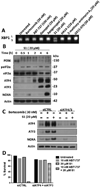The putative BH3 mimetic S1 sensitizes leukemia to ABT-737 by increasing reactive oxygen species, inducing endoplasmic reticulum stress, and upregulating the BH3-only protein NOXA
- PMID: 24072590
- PMCID: PMC3947354
- DOI: 10.1007/s10495-013-0910-y
The putative BH3 mimetic S1 sensitizes leukemia to ABT-737 by increasing reactive oxygen species, inducing endoplasmic reticulum stress, and upregulating the BH3-only protein NOXA
Abstract
S1 is a putative BH3 mimetic proposed to inhibit BCL2 and MCL1 based on cell-free assays. However, we previously demonstrated that it failed to inhibit BCL2 or induce apoptosis in chronic lymphocytic leukemia (CLL) cells, which are dependent on BCL2 for survival. In contrast, we show here that S1 rapidly increases reactive oxygen species, initiates endoplasmic reticulum stress, and upregulates the BH3-only protein NOXA. The BCL2 inhibitors, ABT-737, ABT-263, and ABT-199, have demonstrated pro-apoptotic efficacy in cell lines, while ABT-263 and ABT-199 have demonstrated efficacy in early clinical trials. Resistance to these inhibitors arises from the upregulation of anti-apoptotic factors, such as MCL1, BFL1, and BCLXL. This resistance can be induced by co-culturing CLL cells on a stromal cell line that mimics the microenvironment found in patients. Since NOXA can inhibit MCL1, BFL1, and BCLXL, we hypothesized that S1 may overcome resistance to ABT-737. Here we demonstrate that S1 induces NOXA-dependent sensitization to ABT-737 in a human promyelocytic leukemia cell line (NB4). Furthermore, S1 sensitized CLL cells to ABT-737 ex vivo, and overcame resistance to ABT-737 induced by co-culturing CLL cells with stroma.
Conflict of interest statement
All authors declare that they have no conflicts of interest
Figures




References
-
- Hanahan D, Weinberg Robert A. Hallmarks of cancer: The next generation. Cell. 2011;144:646–674. - PubMed
-
- Walensky LD. BCL-2 in the crosshairs: tipping the balance of life and death. Cell Death Differ. 2006;13:1339–1350. - PubMed
-
- Roberts AW, Seymour JF, Brown JR, Wierda WG, Kipps TJ, Khaw SL, Carney DA, He SZ, Huang DCS, Xiong H, Cui Y, Busman TA, McKeegan EM, Krivoshik AP, Enschede SH, Humerickhouse R. Substantial susceptibility of chronic lymphocytic leukemia to BCL2 inhibition: results of a phase I study of Navitoclax in patients with relapsed or refractory disease. J of Clin Oncol. 2012;30:488–496. - PMC - PubMed
Publication types
MeSH terms
Substances
Grants and funding
LinkOut - more resources
Full Text Sources
Other Literature Sources
Research Materials

